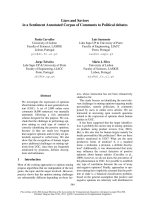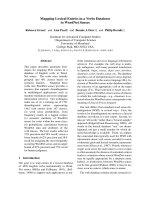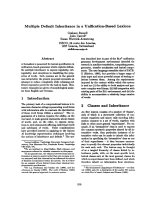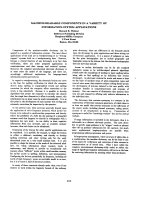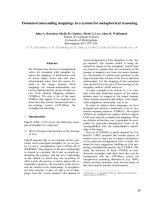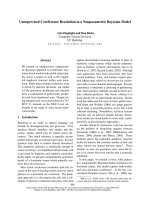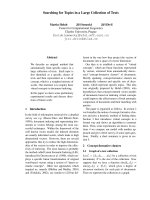báo cáo khoa học: " Post-operative Aspergillus mediastinitis in a man who was immunocompetent: a case report" potx
Bạn đang xem bản rút gọn của tài liệu. Xem và tải ngay bản đầy đủ của tài liệu tại đây (661.71 KB, 4 trang )
CAS E REP O R T Open Access
Post-operative Aspergillus mediastinitis in a man
who was immunocompetent: a case report
George Dimopoulos
1*
, Iraklis Tsangaris
1
, Garyphalia Poulakou
2
, John Panayiotides
3
, George Tsaknis
1
,
Stylianos Orfanos
1
, Apostolos Armaganides
1
Abstract
Introduction: Aspergillus spp. infections mainly affect patients who are immunocompromised, and are extremely
rare in immunocompetent individuals.
Case presentation: Aspergillus post-operative mediastinitis is considered to be a devastating infection, usually
affecting patients un dergoing cardiothoracic surgery with specific predisposing factors. We describe the case of an
immunocompetent 68-year-old Caucasian man with severe chronic thromboembolic pulmonary hypertension, who
underwent pulmonary thromboendarterectomy and developed post-operative mediastinitis due to Aspergillus
flavus. The environmental control did not reveal the source of A. flavus infection and, despite combined antifungal
therapy, our patient died as a result of septic shock and multiple organ failure.
Conclusion: Aspergillus mediastinitis mainly affects patients after cardiosurgery operations with predisposing
factors, and it is unusual in patients who are immunocompetent. The identification of the Aspergillus spp. source is
often diffi cult, and there are no guidelines for the administration of pre-emptive therapy in this population of at-
risk patients.
Introduction
Aspergillus spp. infections mainly affect patients who are
immunocompromised, usually being acquired by inhala-
tion of small airborne spores [1,2]. The diagnosis of
infection caused by this filamentous fungus poses many
difficulties, mainly due to the l ack of a laboratory
method able to discriminate colonization from infection.
Not surprisingly, the diagnosis is often confirmed by
autopsy [1-3]. The difficulty in diagnosis may lead to
delayed treatment, which could be associated with the
extremely high mortality rates. Post- surgical mediastini-
tis is defined as an infection involving the structures
between the sternum and the esophagus, occurring
mainly after cardiothoracic surgery [4-6]. The highest
risk for the development of this infection is associated
with orthotopic heart transpl antation (2.5 to 6 instances
per 100 procedures), while the species usually involved
are Staphylococcus and Enterobacter spp. [7]. Asp ergillus
spp. infections have been described post-operatively in
this patient population, but Aspergillus mediastinitis has
been reported in only 11 patients [1]. A recent pub-
lished study by Jensen et al. reported two cases of med-
iastinitis among seven cases of post-surgical infection,
with a mortality of 100% [8].
We describe post-operative Aspergillus mediastinitis in
our patient, who underwent pulmonary thromboendar-
terectomy (PEA). We focus on the clinical dilemmas
that could be met and cover the early diagnosis , the dif-
ficulties associated with detection of the source of
Aspergillus spp. and the management of our patient.
Case presentation
A 68-year-old Caucasian man with severe chronic throm-
boembolic pulmonary hypertension and progressive
decline to New York Heart Association (NYHA) func-
tional class IV w as admitted to our i ntensive care unit
(ICU) because of respiratory failure and need for mechani-
cal ventilation. His medical history included repeated epi-
sodes of deep vein thrombosis and two episodes of
pulmonary embolism despite adequate anticoagulant ther-
apy. Upon completion of the pulmonary hypertension
investigation, his pulmonary thromboembolic disease was
* Correspondence:
1
Second Department of Critical Care Medicine, ‘ATTIKON’ University Hospital,
University of Athens Medical School, Athens Greece
Full list of author information is available at the end of the article
Dimopoulos et al. Journal of Medical Case Reports 2010, 4:312
/>JOURNAL OF MEDICAL
CASE REPORTS
© 2010 Dimopoulos et al; licensee BioMed Central Ltd. This is an Open Access article distributed under the terms of the Creative
Commons Attribution License ( whi ch permits unre stricted use, distribution, and
reproduction in any medium, provided the original work is properly cited.
considered non-operable and was treated with bosentan
and inhaled iloprost. Follo wing the initiation of mechani-
cal ventilation he was switched to intravenous iloprost and
three months later our patient demonstrated a significant
hemodynam ic imp rovement, allowin g him to unde rgo
PEA. Details on his hemodynamic status and management
are described elsewhere [9].
During his hospitalizatio n, our patient had two epi-
sodes of ICU-acquired microbial and fungal infections
including a catheter related candidaemia due to Can-
dida albicans and St aphylococcus epidermidis (isolated
from the catheter tip of a left internal jugular central
venous catheter, treated with caspofungin for 15 days
and linezolid 600 mg twice a day for 14 days), and an
episode of ventilator-associated pneumonia (VAP) due
to Acinetobacter baumannii treated according to the
detected antimicrobial susceptibilities with imipenem (1
g every six hours) a nd colistin ( 3 × 10
6
Ueveryeight
hours).
Immediately prior to PEA, our patient was given 1 g
of vancomycin as surgical prophylaxis with the induc-
tion of anesthesia. D uring the first post-operative week
he was febrile without an apparent site of infection and
received antibiotic treatment according to the surveil-
lance cultures. On the eighth post-operative day an exu-
date drained automatically from the s urgical wound;
cultures grown in Sabouraud dextrose a gar revealed a
fast-growing isolate with cottony texture identified as
Aspergillus spp. Microscopically, a potassium hydroxide
mount confirmed the presence of septate and hyaline,
and dichotomously branched hyphae. Conidiophores
were uncolor ed producing spherical to ellipsoidal acces-
sory conidia, covering the entire surface of the biseriate
species. Further subcultures in potato f lake agar (PFA)
were prepared in-house a nd incubated at 35°C, and
identified the presence of Aspergillus flavus. The isolate
grew rapidly, producing olive-green colonies. When
examined by tape mounts, a slide culture prepared on
PFA cultured isolate r evealed globose vesicles up to 20
μm in diameter, a biseriate arrangement with metulae
and phialides, and globose conidia (3.0 to 6.0 μm in dia-
meter); all features similar to those produced in Sabour-
aud dextrose agar and characteristic for A. flavus.A
computed tomography (CT) scan of his thorax revealed
no specific signs of mediastinitis. Serum and bronchoal-
veolar-lavage galactomannan tests were not performed,
as they were not available at the time. No specific signs
of mediastinitis were seen either.
A combination of liposomal amphotericin B at a dose
of 3 mg/kg daily and voriconazole (6 mg/kg twice a day
for the first day followed by 4 mg/kg twice a day there-
after) were added because of the severity of the infec-
tion, and surgical debridement of the wound was
performed. Despite all the therapeutic measures, the
results of culture tests remained positive for A. flavus
(surgical wound necrotic tissue test results were positive
for hyphae on direct micro scopy after the addition of
KOH) and our patient died on the 26th po st-operati ve
day b ecause of severe septic shock. Our patient under-
went a whole body autopsy. Samples from the sternum,
lungs and myocardial tissue fixed in a 10% buffered for-
mol solution were embedded in paraffin; sections 4 μm
thick stained with hematoxylin and eosin, PAS and Gro-
cott’s silver impregnation stains confirmed the presence
of hyphae with morpholog ic characters pertaining to the
genus Aspergillus [10] (Figures 1 and 2).
A detailed investigation of all patients undergoing sur-
gical operation during the same period was performed.
A total of 50 environmental samples were collected
from various sites in the operating room. Four plates
were left open for one hour, one of them on the surgical
table and the other at various sites on the floor, focusing
on the air conditioning system vents. Various surfaces
were also sampled with cotton-tip swabs. The filters of
the air conditioning system in the surgical room were
replaced and samples culture tested. The central supply
rooms that housed equipment used in cardiac surgery
operations were all inspected for visible signs of mold
contamination or damage that might lead to mold
growth. Routine scheduled maintenance and replace-
ment protocols for equipment and air filters were
reviewed.
None of the patients undergoing surgical operation
during the same period developed infecti on of the surgi-
cal site due to Aspergillus spp. and the results of envir-
onmental samples tested 17 days later were negative. In
two of the tested samples hyphomycetes classified as
Cladodosporium spp. grew on the 17th day, however
these were considered as laboratory contamination.
Figure 1 Fragment of lung tissue with an increased number of
hyphae obtained on autopsy (PAS stain ×100).
Dimopoulos et al. Journal of Medical Case Reports 2010, 4:312
/>Page 2 of 4
These positive samples derived from a storage area in
the surgical room. No further isolation of fungi was
noted f rom the plates, which were kept for one month
after the environment al sampling inoculation. Addition-
ally, a subsequent investigation was performed on the
ICU staff using nasal cultures for possible nasal coloni-
zation with As pergillus spp., also giving negative culture
test results.
Discussion
Aspergillus mediastinitis has been defined by the US
Centers for Disease Control a nd Prevention as the pre-
sence of a positive culture result from a mediastinal
sample plus one of the following: (a) fever of over 38°C,
or (b) chest pain or sternal instability with purulent
effusion in the mediastinum or positive culture results
from surgically obtained sampl es or blood. In a recently
published review Pasqualotto et al. summarized cases of
Aspergillus mediastinitis reported in the literature, all in
patients who had undergone surgery (four with deep
sternal wound infections, two with heart transplantation,
two with aortitis, one wi th patch infection after repaired
Fallot tetralogy and t wo patients who were immuno-
competent who were affected during an outbreak of
aspergillosis related to a contaminated ventilation sys-
tem in the operating room). The authors considered
immunocompromised individuals with defects in alveo-
lar macrophage and neutrophil function as patients at
risk (that is, patients undergoing chemotherapy, bone
marrow recipients, solid-organ transplants, or patients
with congenital or acquired immune disorders). The
automatically drained exudate from th e surgical wound
in our patient, who was feverish, supported the diagno-
sis of mediastinitis, despite the absence of confirmatory
signs from his thorax CT scan. However our patient was
low risk for Aspergillus spp. infection development, since
he did not fulfill the traditional criteria of immunosup-
pression (malignancy, chemotherapy or radiotherapy,
neutropenia, systematic or immunosuppressive diseases,
or systematic steroid treatment). Although our patient
had received a short course (7 days) of treatment with
steroids (50 mg twice a day) during a septic episode, it
is highly unlikely that this resulted in a permanent
altered host response. According to Pasqualotto et al.
the most important and crucial point for the diagnosis
of Aspergillus mediastinitis in patients undergoing car-
diac surgery with destructive wound infections and sam-
ples that give negative culture test results is a high
clinical suspicion [1]. A potential immunomodulatory
factor in our case could be the prolonged prostacyclin
use. Recent experimental data support an immunosup-
pressive role for prostacyclin , through impaired regula-
tion of phagocytosis, bacterial killing, and inflammatory
mediator production, but the extrapolation of these
findings to the clinical setting remains highly speculative
[11].
Environmental investigations did not reveal the source
of contamination in our patient’ s case. Despite the la ck
of an air sampler, a thorough investigat ion was per-
formed without identification an environmental source.
This finding argues against an ongoing source of con-
tamination and is in line with the absence of new cases
of infections with Aspergillus among patients under-
going surgery within our hospital. Nevertheless, a point
source not y et identified cann ot be excluded. However,
based on previous reports of outbreaks through the ven-
tilation system of the operating theater, the air condi-
tioning filters of the cardiac surgery room were replaced
immediately after the ide ntification of the infection [12].
No renovation or construction procedures were being
performed at our hospital during this time period.
Direct inoculation from our patient’sfloracouldbea
possible source, but the common practice of our ICU
department consists of testing of bronchial cultures
(biweekly) as well as u rine and stool cultures (weekly),
and this would have revealed such a previous coloniza-
tion. Pre-existing colonization of bronchial secretions
with Aspergillus spp. and chronic lung disease have been
demonstrated as risk factors in a case-control study of
sternal wound infections, but this was not the case for
our patient [13]. To the best of our knowledge, there is
no recommendation issued for prophylaxis against
Aspergillus infections in immunocompetent hosts [14].
Interestingly, our patient had received a 15-day caspo-
fungin course as pre-emptive treatment for invasive can-
didiasis based on colonization of urine and bronchial
cultures by Candida spp. in conjunction to additional
risk factors (prolonged ICU stay, administration of
broad spectrum antibiotics, central line placement,
Figure 2 Fragment of myocardium with hyphae obtained on
autopsy (Grocott stain ×100).
Dimopoulos et al. Journal of Medical Case Reports 2010, 4:312
/>Page 3 of 4
mechanical ventilation and total parenteral nutrition
administration) [15,16]. The treatment course was ter-
minated 10 days pre-operatively and no selection of
fungi resistant to caspofu ngin was seen on routine sur-
veillance cultures.
Conclusion
Aspergillus mediastinitis mainly affec ts patients under-
going cardiosurgery operations with predisposing factors,
and is unusual in patients who a re immunocompetent.
The identification of the source of Aspergillus spp. is
often difficult, and there are no guidelines for the admin-
istration of pre-emptive therapy in this population. Our
patient could be added to the series of Pasqualotto and
Denning as a third immunocompetent patient with post-
operative Aspergillus spp. mediastinitis [1].
Consent
Written informed consent was obtained from the patient
for publicatio n of this case report and any accompany-
ing images. A copy of the written consent is available
for review by the Editor-in-Chief of this journal.
Author details
1
Second Department of Critical Care Medicine, ‘ATTIKON’ University Hospital,
University of Athens Medical School, Athens Greece.
2
Fourth Department of
Internal Medicine, ‘ATTIKON’University Hospital, University of Athens Medical
School, Athens Greece.
3
Second Department of Pathology,
‘ATTIKON’University Hospital, University of Athens Medical School, Athens
Greece.
Authors’ contributions
GD, IT, GT and GP analyzed and interpreted data from our patient with
regard to ICU admission, surgical procedure and microbiology. JCP
performed the histological examination of the myocardium and the lung,
and SO and AA were major contributors to the writing of the manuscript.
All authors read and approved the final manuscript.
Competing interests
The authors declare that they have no competing interests.
Received: 19 September 2009 Accepted: 23 September 2010
Published: 23 September 2010
References
1. Pasqualotto AC, Denning DW: Post-operative aspergillosis. Clin Microbiol
Infect 2006, 12:1060-1076.
2. Dimopoulos G, Vincent JL: Candida and Aspergillus infections in critically
ill patients. Clin Intens Care 2002, 13:1-12.
3. Dimopoulos G, Piagnerelli M, Berre J, Eddafali B, Salmon I, Vincent JL:
Disseminated aspergillosis in intensive care unit patients: an autopsy
study. J Chemotherapy 2003, 15:71-75.
4. Levin T, Suh B, Beltramo D, Samuel R: Aspergillus mediastinitis following
orthotopic heart transplantation: case report and review of the
literature. Transpl Infect Dis 2004, 6:129-131.
5. King RC, Barnes AD: Mediastinitis after cardiac surgery. Curr Treat Opt Inf
Dis 2003, 5:377-386.
6. Kronman MP, Baden HP, Jeffries HE, Heath J, Cohen GA, Zerr DM: An
investigation of Aspergillus cardiac surgical site infections in 3 pediatric
patients. Am J Infect Control 2007, 35:332-337.
7. Jensen J, Guinea J, Torres-Narbona M, Muñoz P, Peláez T, Bouza E: Post-
surgical invasive aspergillosis: an uncommon and under-appreciated
entity. J Infect 2010, 60:162-167.
8. Forestier E, Remy V, Lesens O, Martinot M, Hansman Y, Eisemann B,
Christmann D: AcaseofAspergillus mediastinitis after heart
transplantation successfully treated with liposomal amphotericin B,
caspofungin and voriconazole. Eur J Clin Microbiol Infect Dis 2005,
24:347-349.
9. Tsangaris H, Armaganidis A, Argentos S, Chamogeorgakis T, Rallidis L,
Lekakis J, Orfanos SE: Preoperative optimization with prostanoids for
severe chronic thromboembolic pulmonary hypertension (CTEPH): a
step forward? J Heart Lung Transpl 2007, 26:1346-1347.
10. Binford CH, Dooley JR: Aspergillosis. In Pathology of Tropical and
Extraordinary Diseases. Edited by: Binford CH, Connor DH. Washington, DC:
AFTP; 1976:2:562-563.
11. Aronoff DM, Peres CM, Serezani CH, Ballinger MN, Carstens JK, Coleman N,
Moore BB, Peebes RS, Faccioli LH, Peters-Golden M: Synthetic prostacyclin
analogs differentially regulate macrophage function via distinct analog-
receptor binding specificities. J Immunol 2007, 178:1628-1634.
12. Heinemann S, Symoens F, Gordts B, Jannes H, Nolard N: Environmental
investigations and molecular typing of Aspergillus flavus during an
outbreak of postoperative infections. J Hosp Infect 2004, 57:149-155.
13. Richet HM, McNeil MM, Davis BJ, Duncan E, Strickler J, Nunley D, Jarvis WR,
Tablan OC: Aspergillus fumigatus sternal wound infections in patients
undergoing open heart surgery. Am J Epidemiol 1992, 135:48-58.
14. Vonberg RP, Gastmeier P: Nosocomial aspergillosis in outbreak settings. J
Hosp Infect 2006, 63:246-254.
15. Walsh TJ, Anaissie EJ, Denning DW, Herbrecht R, Kontoyiannis DP, Marr KA,
Morrison VA, Segal BH, Steinbach WJ, Stevens DA, van Burik JA, Wingard JR,
Patterson TF, Infectious Diseases Society of America: Treatment of
aspergillosis: clinical practice guidelines of the Infectious Diseases
Society of America. Clin Infect Dis 2008, 46:327-360.
16. Ostrosky-Zeichner L, Sable C, Sobel J, Alexander BD, Donowitz G, Kan V,
Kauffman CA, Kett D, Larsen RA, Morrison V, Nucci M, Pappas PG,
Bradley ME, Major S, Zimmer L, Wallace D, Dismukes WE, Rex JH:
Multicenter retrospective development and validation of a clinical
prediction rule for nosocomial invasive candidiasis in the intensive care
setting. Eur J Clin Microbiol Infect Dis 2007, 26:271-276.
doi:10.1186/1752-1947-4-312
Cite this article as: Dimopoulos et al.: Post-operative Aspergillus
mediastinitis in a man who was immunocompetent: a case report.
Journal of Medical Case Reports 2010 4:312.
Submit your next manuscript to BioMed Central
and take full advantage of:
• Convenient online submission
• Thorough peer review
• No space constraints or color figure charges
• Immediate publication on acceptance
• Inclusion in PubMed, CAS, Scopus and Google Scholar
• Research which is freely available for redistribution
Submit your manuscript at
www.biomedcentral.com/submit
Dimopoulos et al. Journal of Medical Case Reports 2010, 4:312
/>Page 4 of 4
